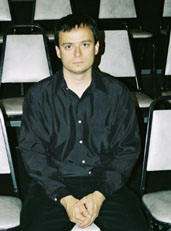
Rusty Banks is a composer/guitarist/teacher originally from Jasper, AL, now living in Pennsylvania.
His compositions benefit from themes relating to regions or environments. For example, his composition commissioned by the Alabama Music Teacher Association's 2004 convention featured audio samples from the Cahaba River, Alabama's last free-flowing river. Another work, "Long Pine Creek: New Year's Day," uses sounds from Long Pine Creek in Nebraska. His compositions range from traditional concert music to sonic installations where boom boxes are scattered throughout a room. His music is described as thoroughly modern, yet accessible, a description he shudders at, but reluctantly accepts. His compositions may be heard on Living Artist Recordings, as well as his web site, rustybanks.org.
|

Monday, February 20, 2006
But do you SEE what I mean?
What is good film music like?
Usually, it is simple and evocative. Most good film music is pretty lame by itself, because it exists to strengthen a mostly visual expression. So couldn’t the emphasis be shifted the other way? What if a film is used to “underscore” a composition? Actually, this practice is common, even if this terminology is not.
Remember the first time you heard a “tape” piece presented at a concert?
It didn’t work did it? I mean, maybe the piece works, but what about the presentation? There are several pieces for recorded media alone that I love, but I don’t ever want to hear them in a darkened room full of bored composers again. I’d rather hear these works at home, on headphones.
What about live performers?
I love to watch ensembles, large and small, perform with passion, IF it guides my listening. There can be a lot going on in a symphonic work, and catching something out of the corner of my eye can bring to my attention something I might have missed. Stravinsky ridiculed the “eye-closers.” Sure, sometimes, solo performers just ham it up a bit too much. In those cases I close my eyes, and often find that the performance is as sonically empty as their motions are distracting.
But what about projections, sculpture, staging etc?
If a composer concentrates more on the visual aspects of a work than the music, the work may suffer, but the same can be said for orchestration, notation, unorthodox instruments, piece titles, and program notes. Either these things enhance or they don’t.
The New Music Agency always presents a concert close to New Year’s Eve that is reflective in nature. We then play “In C” as a sort of after-concert thing where people listen, meditate, walk around, dance, roll their eyes, whatever. We do the “real” version that is AT LEAST 45 minutes. Last time, we projected the score behind us. People loved that. For one thing, it’s sort of “dare-devil” to let people in on what you are trying to accomplish, but it also begged people to ask themselves, “well, what chunk is THAT guy supposed to be playing?” I think this would be a great idea for any Berio Sequenza as well. Again, those who wanted to meditate to the piece closed both eyes, to make their eyes single
Simple but elegant staging…
For a performance we did at the Lied Center (Lincoln, Nebraska’s premiere performing arts center) I presented one of my works in a mega-hip, visually beautiful way, simply for practical reasons. My piece used three performers, hi-fi playback, and boom boxes spread throughout the room. The space made it impractical to surround the audience as I usually do, so I worked with the stage hands to suspend the boomboxes above the performers. The problem was that the performers had to push play on the boomboxes. We worked out a pulley system, where the performers would start their boomboxes and hoist them to the desired height, and clip a carabiner to a bar. This was in front of an entirely mirrored wall. The audience was hooked. If only we could have rappelled into the space!
With bemused resignation…
Once, when the New Music Agency presented Varese’s Poem Electronique as part of a “coherent narrative,” our artistic director handed out a map of The Hundred Acre Wood, but with the place names replaced with music descriptors that would guide the listeners through the piece. Now, anyone who knows me knows this is WAY too warm and fuzzy for my dark, brooding, post modern point of view. Whatever. Did the average audience member experience the full depth of the Varese in this experience? Of course not. No one does, in the first listen, in any circumstance. Did they experience the work on a deeper level than they would have in a darkened room? Definitely. For us snobs that won’t be pandered to, we can throw the paper on the floor and shut our eyes. I, for one, just might take a peek.
posted by Rusty Banks
|
| |



